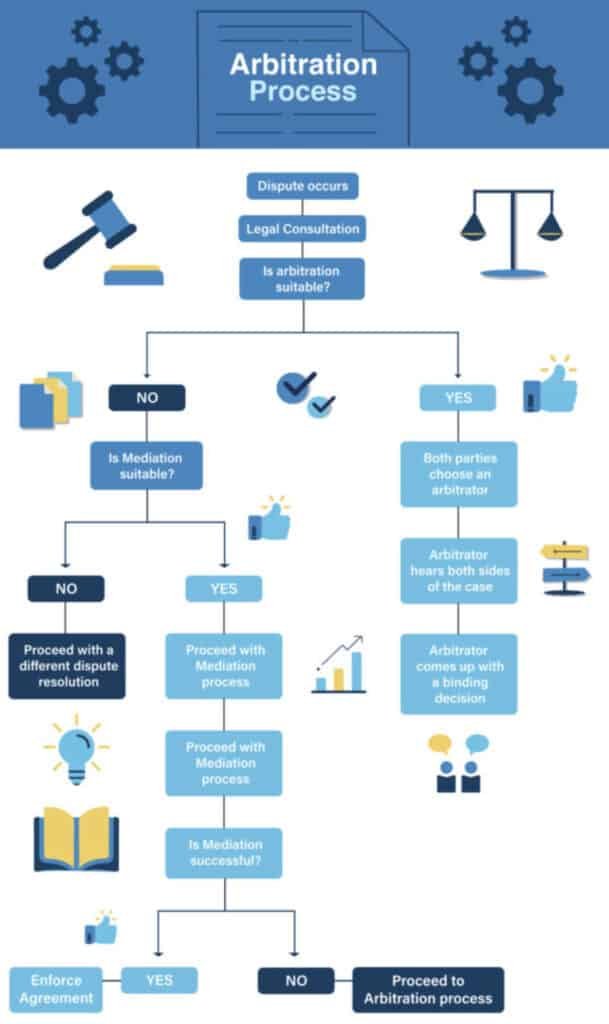Arbitration Process in Bangladesh
The Legal regime of Commercial Arbitration in Bangladesh
Humans are gregarious, and life in society necessitates constant interaction with others, which frequently results in conflicts and disputes in personal, commercial, and professional relationships.
To preserve social harmony, peace, development, and progress, business and commercial disputes must be resolved rapidly.
Rapid growth in trade and business within and outside the country led to an explosion in the number of disputes, the majority of which required prompt resolution.
The legal framework for international arbitration in Bangladesh, with a focus on Bangladesh’s role as an international arbitration seat Already, it has been argued that the relationship between the court and the arbitral tribunal is crucial for the efficient resolution of a transnational dispute.
Before discussing the law that governs international arbitration in Bangladesh, a brief description of the country’s court system is necessary to comprehend the relationship between national courts and arbitral tribunals.
National courts and arbitral tribunals in Bangladesh
The Bangladesh Supreme Court consists of the High Court Division (HC Division) and the Appellate Division (AD). The court’s authority is derived from the Bangladeshi constitution. The Appellate Division hears appeals against the decisions of the High Court Division on constitutionally mandated matters or by granting leave.
No original jurisdiction exists. In contrast, the HC has original, appellate, and other jurisdictions under the constitution and other statutes. Notably, the law declared by the AD is binding on the HC, and the law declared by either division is binding on all courts and tribunals subordinate to it.
The HC is vested with matters involving international commercial arbitration, excluding the enforcement of awards. In the hierarchy of courts with civil jurisdiction, the court of the district judge comes next to the HC. It ensures the award’s enforcement within its territorial jurisdiction.
In arbitration law, Bangladesh inherited the colonial inheritance. During the British regime, the Bengal Regulation of 1772 governed arbitration in this region under the presidency of the then-government. Later, the Civil Procedure Code of 1908 included arbitration regulations.

The Arbitration (Protocol and Convention) Act of 1937 and the Arbitration Act of 1940 existed at the time of the partition of British-ruled India in 1947.
Both acts continued into Bangladesh’s post-independence period. Bangladesh, a signatory to the New York Convention,156 enacted the Arbitration Act, 2001, based on the UNCITRAL Model Law, By adopting the Act 2001, Bangladesh accepts the jurisdictional theory of international arbitration to a large extent.
Nevertheless, the Act diverges significantly from the Model Law in numerous ways. This chapter focuses primarily on the deviations from the Act and their effects on Bangladesh-based arbitration.
The 2001 Act repealed the 1937 and 1940 Acts. The most recent amendments to the Act regarding court-issued interim measures were made in 2004. Although the Act gives the government and the Supreme Court the authority to establish rules for carrying out the Act’s purposes, neither the government nor the Supreme Court have done so as of yet.
The original language of the statute is Bangla. The official English text has not yet been released. This research utilized a non-official English version of the statute.
According to the preamble, the Act enacts the law regarding international commercial arbitration, the recognition and enforcement of foreign arbitral awards, and other arbitrations.
Although the Act of 2001 makes specific reference to international commercial arbitration in its preamble, it essentially established a single, unified arbitral regime applicable to both domestic and international arbitration.
The first international arbitration institution in Bangladesh is called the Bangladesh International Arbitration Centre (BIAC). It began operating in April 2011 with permission from the government and is registered as a non-profit organization.
Sponsors of BIAC include the Metropolitan Chamber of Commerce & Industry (MCCI), Dhaka Chamber of Commerce & Industry (DCCI), and International Chamber of Commerce-Bangladesh (ICC-B). Under a cooperation agreement, the World Bank’s private sector arm, the International Finance Corporation (IFC), supported BIAC in its early stages with funding from the European Union and UK Aid.
New York Convention or Model Law
In contrast to many preferred jurisdictions for international arbitration, neither the preamble nor the text of the Act 2001 made any reference to the New York Convention or Model Law.
According to Bangladesh’s international obligation under the New York Convention, this reference is essential. In Saipem v. Bangladesh, it was asserted that Bangladesh violated its international obligation by not respecting Article II of the New York Convention by issuing an anti-arbitration injunction against an ICC tribunal seated in Bangladesh.
In response, Bangladesh stated that the country had not yet passed an act of parliament pursuant to its obligations under the Convention. 163 Consequently, the court was not required to recognize an arbitration agreement.
Notably, Bangladesh’s approach to enforcing international law on its territory is dualistic. In the Saipem case, the ICSID tribunal ruled that Saipem had the right to arbitrate the dispute in Bangladesh in accordance with the International Chamber of Commerce Arbitration Rules.
had been expropriated by Bangladesh through the improper intervention of its courts. 164 The tribunal reasoned that Bangladesh had not disputed that it was not bound by the Convention, even though the Convention might not be binding on its courts.
Saipem’s decision is a landmark in the jurisprudence of investment arbitration, marking the first time an ICSID tribunal held a state accountable for the conduct of its judiciary. Evidently, if this case is any indication, a reference to the Convention in the preamble of the Act would bind the court.
The breadth of the Arbitration Act in Bangladesh
The Act of 2001 has limited application in commercial arbitration, despite the fact that the laws of many preferred seats expand its scope of application. There are only a few provisions in the Act of 2001 that pertain specifically to international commercial arbitration. In its scope, the law states that it shall apply only if the seat of arbitration is within Bangladesh.
In other words, the statute restricts its application to arbitrations seated within Bangladesh. Evidently, the Act of 2001 follows the English Arbitration Act of 1996 on a variety of issues, but it fails to broaden its application in the same way. The Act of 2011 adopts the Indian approach to the applicability of the statute.
According to Section 3(1) of the Act, the Act applies when the place of arbitration is in Bangladesh. The Act also specifies that sections 45, 46, and 47 of the Act shall apply if the place of arbitration is outside of Bangladesh. Therefore, it is reasonable to conclude that the Act has no application to arbitrations seated outside the United States, with the exception of award recognition and enforcement.
Already overburdened with heavy caseloads, the courts were unable to handle the additional cases. The resulting backlog significantly slowed down the legal system in Bangladesh.
Without a corresponding rate of conflict resolution, there was a veritable blockade of development, which negatively impacted the economy of the country. This prompted the development of an ADR (alternative dispute resolution) mechanism.
Mediation, conciliation, and arbitration comprise ADR. In contrast to the first two, which involve party-identified solutions accepted by consensus, the third involves a neutrally-identified resolution that is binding on the disputants.
Consensus and party autonomy serve as the basis for the arbitral process, which begins with the agreement to arbitrate and concludes with the award of the arbitral tribunal and its enforcement.
Arbitration was originally a non-formal process, but it has since evolved into a specialized area of law. Achieving the objective of a fair, legal, and enforceable award necessitates dexterous maneuvering through a number of tricky situations in order to navigate the path and reach the destination of an award that is fair, legal, and enforceable.
There are numerous pitfalls on the path of domestic or international commercial arbitrations and those under bilateral investment treaties for the unwary and inexperienced.
PRE-ARBITRATION PREPARATION
The evaluation of a party’s preparedness for the dispute is the most undervalued yet crucial phase of any arbitration proceeding. Once a party has determined that a valid dispute exists, the first step for a practitioner is to examine the arbitration agreement.
Given that some of the disputes stem from contracts executed prior to the 1996 Arbitration Act or the 2001 or 2019 Amendment, it is essential to determine the fundamental characteristics of all proceedings, as well as the applicable law and the location of the dispute.
Determine the governing law and location

Typically, in domestic arbitrations, Bangladeshi law will govern, but the location of the arbitration must be specified. Rarely do pathological clauses specify the legal seat of the arbitration. In such situations, one can rely on case law stating that if an agreement contains an exclusive jurisdiction clause, that clause can be interpreted as the seat of arbitration.
There are still a number of disputes in Bangladesh regarding the interpretation of the seat and venue of arbitration; therefore, it is essential to determine the location of the seat, as the courts at the seat oversee the arbitration.
Institutional or Ad Hoc Arbitration
Arbitral institutions have their own procedures, timelines, and rules. As a result, parties must assess their financial capabilities prior to initiating the proceedings and pay certain administration fees. In addition to considering the benefits and drawbacks of relying on a third-party funder when assessing financial capacity, parties may wish to consider the advantages and disadvantages of a third-party funder.
In instances where the arbitration is conducted in accordance with institutional rules, the start of the proceedings may depend on when the request for arbitration was submitted to the institution. This may be significant when limitation issues are involved.
Document Evaluation and Method
Prior to initiating arbitration proceedings, assess the merits of the case (based on documents and associated testimony) and ensure that findings and recommendations are communicated to the client in a clear and timely manner.
Need for court-ordered interim relief
Determine the need for interim relief prior to initiating arbitral proceedings. In urgent cases of bank guarantee invocation,’ removal of rigs from territorial waters,’ unloading of goods, and all other appropriate cases, one may approach the court of the principal jurisdiction and seek interim relief under Section 9 of the 2001 Arbitration Act.

Interim Compensation from Emergency Arbitrators
Emergency arbitrators may also provide interim relief prior to the initiation of a lawsuit. Practitioners should evaluate Section 9 of the Arbitration Act versus requesting that the institution appoint an emergency arbitrator.
Experts
An increasingly advantageous trend in larger disputes that require an expert for the valuation of claims and assessment of damages is to retain experts at the outset in order to get a sense of the claims to be asserted. Experts can also assist with the preparation of the claim if a forensic audit of emails, data, or documents is required.
Selection of Arbitrator
For technical disputes, arbitrators should ideally be suitably qualified. Similarly, there are procedural outlines in certain cases, and only empanelled arbitrators can be appointed therein. In Bangladesh, one typically sees this in engineering and infrastructure arbitrations, in which technical (non-legally qualified) experts are sought to be appointed as arbitrators.

Statute of Limitations and Pre-Arbitration Steps
Consider any mandatory pre-arbitration steps (such as mediation) or informal dispute resolution before filing a claim.
NOTICE OF ARBITRATION
The notice of arbitration (NOA) is a crucial document. It outlines the initial parameters of the dispute to be adjudicated by the tribunal and often includes proposals for the party-appointed arbitrator. Most arbitral institutions require the claimant to provide a summary of the dispute and the claims being sought, as well as a valuation of the claims.
The 1996 Arbitration Act states that an arbitration begins when the counterparty receives the Notice of Arbitration (NOA). Relevant documents should be attached to the NOA, and the person issuing and serving the NOA must have the authority and capacity to do so.
CONSTITUTION OF TRIBUNAL
Depending on the facts and circumstances, either the opposing party or the institution may participate in the selection of arbitrator(s). In accordance with its rules, the institution deems the tribunal to be constituted upon nomination, necessary declarations and disclosures, and the absence of objection from the parties.
- It is imperative that potential arbitrators disclose all potential conflicts, i.e., any reasons for a lack of independence or impartiality, at the outset.
- Understanding the preferences and biases of the arbitrator(s) can play a significant role in guiding the proceedings in the most advantageous direction for the clients. Typical components of pre-appointment arbitrator due diligence include:
- awards and decisions pertinent to the immediate dispute;
- counsel or expert witness testimony and positions taken;
- publications and addresses;
- current and previous professional affiliations that could pose a conflict of interest with the parties, counsel, or experts.
PRELIMINARY MEETING
The preliminary meeting is the initial phase of any arbitration procedure. It typically occurs after the tribunal has been appointed but prior to the issuance of the first procedural order. If a party must raise jurisdictional objections or challenges to the tribunal’s composition, it is preferable to do so at this stage (if not already done).
The preliminary meeting gives the tribunal, parties, and counsel discretion over the procedural aspects of the arbitration. Typically, at this stage, an attempt is made to establish a broad roadmap for how the arbitration should proceed.
The following is a typical list of topics discussed at preliminary meetings:
(i) clauses on dispute resolution and choice of law, if required;
(ii) disagreements between the parties;
(iii) approach to documents: whether submitted with proposals or later; paper versus electronic filings; translation
(iv) a schedule of hearings on the merits;
language used in proceedings;
(vi) witness evidence: whether expert statements are filed with submissions or later; the number of rounds; simultaneous as opposed to sequential;
(vii) deadlines for filings and pleadings;
(viii) the time, place, and logistics associated with the pre-hearing and hearings;
(ix) attorney ethics and privilege: applicable rules;
(x) administrative secretary: usage considerations; and
(xi) tribunal fees in ad hoc arbitration proceedings
Witnesses
Witnesses are central to the initial hearing’s discussion. In addition to other aspects of witness testimony, the submission of witness or expert statements alongside submissions and the necessity of translations are considered.
The tribunal may determine the scope of witness testimony if the parties have disclosed the number of witnesses they intend to produce.
This can be difficult in multiparty arbitrations, and we will discuss the relevant considerations later on in this chapter.
Foreign Counsel
Specifically, in international commercial arbitrations, the disputing parties are frequently represented by counsel from different jurisdictions, and there may be varying approaches to procedural aspects in their respective countries. In such circumstances, a thorough initial hearing is essential for the smooth progression of the arbitration.
Regarding domestic or Bangladeshi-seated hearings, it is commonly believed that international counsels face issues with some unique procedural requirements, such as the marking of documents and affidavits of admission and denial, which are essentially an overlap of the Code of Civil Procedure, 1909 (CPC) in the arbitration proceedings in Bangladesh.
PREPARATION FOR INITIAL HEARING/PRE-HEARING CONFERENCE
This step invariably entails an evaluation of the claimant’s legal position, evidence, and key witnesses, as well as a familiarization with the client’s ultimate goals.

Concluding a Deal with the Opposing Party
Unlike national adjudication in front of a court, arbitration is based on party autonomy. Therefore, it is best to agree on procedural, venue, and cost aspects at the outset. A lot of discussions revolve around venues if the choice has to vary from each hearing to the next, and a fixed venue goes a long way in stabilizing the same.
Procedures and Schedules
A practitioner’s primary objective should always be to complete an arbitration proceeding in a timely and efficient manner without disregarding due process rights. Instead of multiple hearings spread out over time, a week of continuous hearings followed by post-hearing briefs is recommended.
Planning for Procedures
Occasionally, tribunals prefer to hold a pre-hearing conference to ensure that all logistics are in place for the hearing. At this stage, the tribunal determines the breakdown of the hearing’s schedule, and if the hearing is held virtually, emergency contact persons for the parties are designated and network connections for everyone dialing in are verified.

Unforeseen events and any other force majeure circumstances can necessitate the use of technology and virtual hearings. Additionally, international commercial arbitration frequently involves participants residing in different countries, which should encourage parties to prefer online arbitration using video conferencing facilities.
Given the time-sensitive nature of proceedings, if one disrupts a hearing due to logistical issues or witness unavailability, it may cause more damage to the proceedings. Likewise, neutrality and no prompting of responses from witnesses must be maintained in such situations.
It would be prudent to conduct a trial run of the facilities prior to the actual hearing and to have opposing counsel present during the cross-examination of the witness.
DRAFTING SUBMISSIONS AND COLLECTING EVIDENCE
Arbitration proceedings are not court hearings, and the pleadings must be drafted in a very different manner. Arbitrators appreciate concise, to-the-point drafting in plain English.
Delineate issues, address claims, reference exhibits, and include the methodology on which valuation is done. Even in cases where liquidated damages have been provided, a valuation by experts or a basic computation of damages is required.
Frequently, applications and responses for requests for time, submissions, and the discovery of documents are submitted via email.
The general rule is that denied or disputed documents do not need to be proven by oral evidence.’ Witnesses must be carefully selected based on a number of factors, such as their position within the organization, their role in contract negotiations and the alleged dispute, and their knowledge of relevant documents.
Discovery and Rules of Evidence
In ad hoc proceedings, cross-examination of witnesses may not be time-limited as strictly as it is in institutional arbitrations; however, in all such cases, strict adherence to the rules adopted or determined by the tribunal is required.
In international arbitrations, the IBA Rules of Evidence govern, among other things, the relevance, materiality, and admissibility of documents; the mode of requesting documents; the request of documents in the possession or custody of the opposing party; etc. These rules may be adopted.
The ‘Redfern Schedule’ organizes the request for the production of documents. *” The Redfern Schedule contains four rows or headings that must be contributed to by the parties, their counsels, and the arbitral tribunal, namely:
a) the request to disclose;
b) the reason for the request;
c) the objecting party’s response; and
d) the arbitral tribunal’s ruling with brief explanations thereof. This is primarily due to the fact that the vast majority of these requests are merely fishing expeditions, thereby increasing the tribunal’s unnecessary workload and the cost of arbitration.
HEARING
Opening Statement

In the opening statement, the attorneys make their first substantive arguments in the arbitration. At this stage, the party or advocate should also address all jurisdictional issues and, depending on the facts of the case, seek a preliminary ruling on the same.
A good opening statement typically includes a concise summary of the relevant facts and issues, highlighting subtly that both the best-case and worst-case scenarios favor their party. This must utilize the evidence and documentation used to reach these conclusions in an effective manner.
In addition, it must be followed by an explanation of the party’s key legal positions, with the option of including case law. At this time, the most defensible arguments are those that are sector-specific and generally commercially sensible. This may be combined with a rebuttal or preemption of the opposing counsel’s arguments.”
The tribunal will have reviewed the submissions of the parties. Therefore, it is unnecessary to reiterate every aspect of the written phase.
Important decisions must be made regarding which claims to pursue, as the record at this stage includes the written pleadings, evidence, and supporting documents. In order to make an impression on the tribunal, some attorneys drop some of their claims immediately.
Cross-Examination
In arbitration, as opposed to a civil lawsuit, the issues framed are heavily claim-centric and not always declaratory or interpretive. In such a scenario, the primary evidence consists of documents. Thus, the purpose of an appropriate cross-examination in an arbitration is to demonstrate that the witness statement is inconsistent with the records or that the witness lacks knowledge of the pertinent facts.
Generally, you should avoid the court trial procedure of asking multiple questions on the same point if you have received a favorable response that can be linked to the document at hand and have decided to move on. Continuing to question the witness in the hope of eliciting a positive response may allow the witness to add additional damaging information to the record.
Before beginning cross-examination, it is essential to carefully review all relevant witness statements. Attempt to understand the witness as a person.
The following are some additional considerations for cross-examination:
To Cross-Examine or Not?
Contrary to popular belief, there is no rule requiring adverse counsel to cross-examine a witness. In fact, cross-examining a knowledgeable and articulate opposition witness can be extremely detrimental when attempting to build a strong case. Witnesses frequently have vested interests at stake.
The following factors must be considered when making this determination:
(i) the significance of the topics addressed by the witness;
(ii) the nature and admissibility of the witness’ written testimony.
harm the attorney;
(iii) the significance of the omitted arguments and the importance
tance of bringing to light these omissions;
(iv) the presence of unexplained gaps between the witness’s account and the physical evidence.
relevance of these gaps therebetween; and
(v) witness credibility.
There may be times when opposing witnesses delay and stall the cross-examination. In such situations, be prepared to cut the testimony short. Similarly, if time is limited, be prepared to exclude a witness from cross-examination. This phenomenon is particularly prevalent in international arbitration proceedings.
Witness Conduct and Remedy

In situations involving uninterested or excessively laborious and verbose witnesses, it is of the utmost importance that attorneys suppress any trace of frustration. Instead, they must maintain composure and direct the uncooperative witness to the main point being made.
Despite the general prohibition against it, witnesses are sometimes prepared and repeat answers that they have deemed appropriate for each type of question. In such situations, break the chain and ask unrelated, difficult-to-anticipate questions.
Similarly, when examining experts, it is essential to note whether they are independent experts or professionals who are following instructions. It is ineffective to harass or coerce them into speaking. The majority of experts testify multiple times per year; therefore, they are frequently better prepared than fact witnesses.
Questions pertaining to the experts’ report, instructions received, and/or assumptions made are pertinent. It is prudent to enlist the aid of one’s own experts during cross-examination or even to suggest hot tubbing if deemed appropriate.
Organization and Presentation
The structuring and formulation of the written submissions in an effective and, more importantly, persuasive manner is a very admirable quality. The written arguments must be written in such a way that the tribunal remains interested and comprehends the case the attorney is attempting to build.
The written arguments must ensure that the tribunal appreciates and is persuaded by the arguments presented by the attorney. Several guidelines are detailed below:
(i) Submissions must be concise and accurate;
(ii) Do not stray from the case theory and the goal of persuading the judge.
court to adopt it;
(iii) provide a concise but thorough outline of how the submissions (both
Oral and written skills will improve.
(iv) provide a concise and comprehensive summary of the arguments;
(v) use clearly delineated sections and subsections that follow a logical progression;
(vi) create an exhaustive index or table of contents; and (vii) utilize tables, annexures, schedules, and diagrams effectively.
Cost Submissions
In addition to the foregoing, one must also file cost submissions, which include legal fees, tribunal fees, travel, lodging, and all other types of costs incurred as a result of the proceeding, as required by Section 31A of the 2001 Act. Proof of such expenses must be provided alongside the cost schedule, along with an explanation of why the applicant is entitled to reimbursement. Parties can recover substantial sums if their cost submissions are well-written.
SECOND SEAT
The second chair’ is the team member who sits next to the lead counsel (first chair) and serves as second-in-command throughout the proceedings. The second chair must always be prepared to argue the case if necessary. The primary function of a second chair is to serve as the first chair’s eyes and ears.
Some Important characteristics include:
(i) be well-versed in the relevant facts and case law cited in the argument;
(ii) are very familiar with the annexures and common core bundle. Frequently, the attorneys arguing remember the document, whereas the appropriate
Preferably, reference should be made thereto;
(iii) Examine the transcripts and call attention to any admissions and/or misrepresentations.
tations;
Organization and Presentation
The structuring and formulation of the written submissions in an effective and, more importantly, persuasive manner is a very admirable quality. The written arguments must be written in such a way that the tribunal remains interested and comprehends the case the attorney is attempting to build.
The written arguments must ensure that the tribunal appreciates and is persuaded by the arguments presented by the attorney. Several guidelines are detailed below:
(i) Submissions must be concise and accurate;
(ii) Do not stray from the case theory and the goal of persuading the judge.
court to adopt it;
(iii) provide a concise but thorough outline of how the submissions (both
Oral and written skills will improve.
(iv) provide a concise and comprehensive summary of the arguments;
(v) use clearly delineated sections and subsections that follow a logical progression;
(vi) create an exhaustive index or table of contents; and (vii) utilize tables, annexures, schedules, and diagrams effectively.
Cost Submissions
In addition to the foregoing, one must also file cost submissions, which include legal fees, tribunal fees, travel, lodging, and all other types of costs incurred as a result of the proceeding, as required by Section 31A of the 2001 Act.
Proof of such expenses must be provided alongside the cost schedule, along with an explanation of why the applicant is entitled to reimbursement. Parties can recover substantial sums if their cost submissions are well-written.
SECOND SEAT
Some Important characteristics include:
The second chair’ is the team member who sits next to the lead counsel (first chair) and serves as second-in-command throughout the proceedings. The second chair must always be prepared to argue the case if necessary. The primary function of a second chair is to serve as the first chair’s eyes and ears.
(i) be well-versed in the relevant facts and case law cited in the argument;
(ii) are very familiar with the annexures and common core bundle. Frequently, the attorneys arguing remember the document, whereas the appropriate
Preferably, reference should be made thereto;
(iii) Examine the transcripts and call attention to any admissions and/or misrepresentations.
tations;
(iv) take note of the reaction of the tribunal members and the body language of the witnesses during the cross-examination and provide useful feedback.
Arbitration and the court system are intertwined. This chapter has emphasized the importance of planning for interim orders. In accordance with the 1996 Arbitration Act and its 2001 Amendment, courts may be consulted for assistance with other matters. Section 5 of the 1996 Arbitration Act limits the involvement of the courts to the extent permitted by the Act,
which includes:
(i) application under Section 44 or Section 45 of the 1996 Arbitration Act, as applicable, to refer parties from court or tribunal proceedings initiated by any party to arbitration. Inaction may constitute a waiver under Section 4 of the Act.
(ii) selection of an arbitrator pursuant to Section 11(6);
(iii) requesting the court’s assistance in taking a deposition under Section 27; (iv) requesting the annulment of an arbitral award under Section 34;
(v) appeal a ruling issued under Section 34 through Section 37.
In addition to the foregoing, one may be confronted with anti-arbitration injunction suits in the Bangladeshi context if one observes that interim orders have been granted in the past restraining arbitrations. In such situations, it is crucial to file the necessary applications in the appropriate court or to immediately appeal the said order to a higher forum in order to set it aside.
Are you planning to do arbitration or looking for alternative dispute resolution remedies in Bangladesh?
Tahmidur Rahman Remura Wahid TRW is a full-service law firm that has been dealing with arbitration consisting of a wide range of topics at both international and local level. We have barristers that have specialised in international commercial arbitration from the United Kingdom and accredited civil-commercial mediators.
If you require any assistance or consultation, please visit our office or contact us at +8801779127165 or +8801847220062 (WhatsApp) or by email- info@trfirm.com.
GLOBAL OFFICES:
DHAKA: House 410, ROAD 29, Mohakhali DOHS
DUBAI: Rolex Building, L-12 Sheikh Zayed Road
LONDON: 1156, St Giles Avenue, Dagenham
Email Addresses:
info@trfirm.com
info@tahmidur.com
info@tahmidurrahman.com
24/7 Contact Numbers, Even During Holidays:
+8801708000660
+8801847220062
+8801708080817



